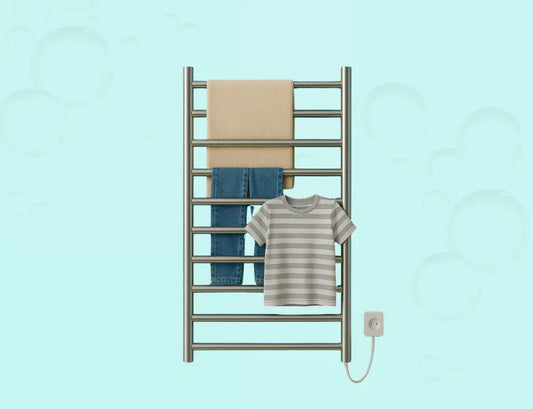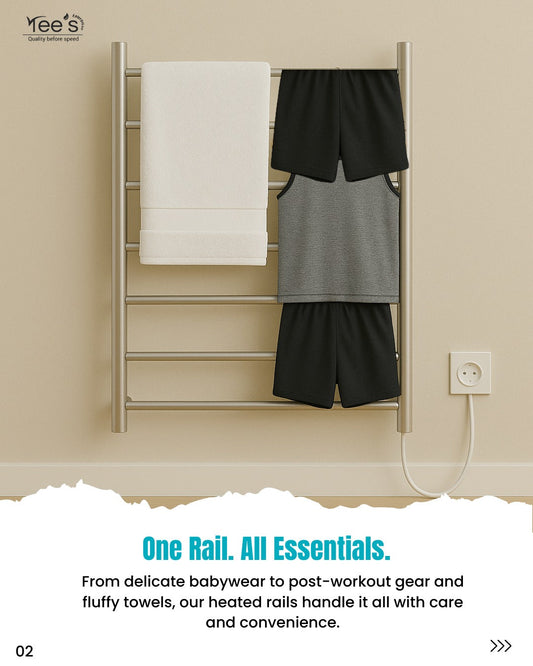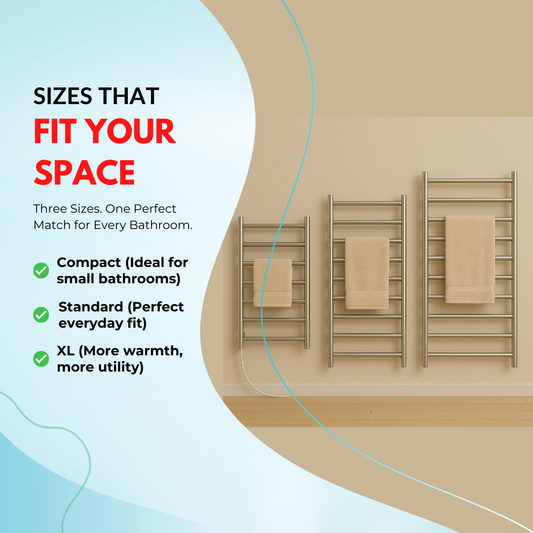Prevent Mold in Laundry with Heated Rails | Fast Indoor Drying Tips India

Monsoon in India brings the much-awaited relief of rain after scorching summers, but it also creates a big household struggle—damp clothes, musty odors, and moldy fabrics. With endless humidity and little sunshine, drying clothes indoors becomes a daily nightmare. Anyone who has faced moldy clothes during monsoon in India knows how unhygienic and frustrating it can get.
A simple yet modern solution to this problem is the heated clothes rail. Compact, energy-efficient, and fabric-friendly, these devices not only dry laundry faster but also prevent mold, odor, and fabric damage.
In this guide, we’ll cover how heated rails work, why they’re perfect for humid Indian weather, and the smartest ways to dry clothes fast indoors without sunlight.
Why Mold and Odor Are So Common During Monsoon
Indian monsoons bring 80%–90% humidity and cloudy skies that linger for weeks. This drastically slows evaporation, leaving clothes damp for hours or even days. The result?
-
Mold and mildew patches on fabrics
-
Musty, unpleasant smells
-
Clothes acting as a breeding ground for bacteria
-
Discoloration and stains due to prolonged dampness
-
Damage to delicate garments
In compact apartments with little ventilation, the problem is even worse. Simply hanging clothes indoors isn’t enough—unless drying is supported by external help.
What Is a Heated Clothes Rail & How Does It Work?
A heated clothes rail is a plug-in appliance with gently warmed bars that speed up indoor drying. Unlike bulky dryers, they work on low wattage (100–250W) and are safe for all fabric types.
Key Benefits Over Traditional Drying:
-
Gentle heat → no shrinkage or fabric damage
-
Energy-efficient → consumes less power than dryers or heaters
-
Portable → lightweight and easy to move indoors
-
Space-saving → foldable or wall-mounted designs
-
Cost-effective → affordable for daily use
For families struggling with moldy clothes in monsoon India, heated rails are a game-changer.
How Heated Rails Prevent Mold
Mold thrives when clothes remain wet for more than 6–8 hours in a warm, stagnant environment. Heated rails break this cycle by:
-
Drying faster → reducing the time dampness lingers
-
Improving ventilation → rising warm air aids circulation
-
Preventing moisture buildup → no water trapped in fabrics
-
Hygienic surfaces → unlike wooden chairs or metal rods, rails are rust-proof and bacteria-resistant
How to Dry Clothes Fast Indoors with Heated Rails
To maximize efficiency, follow these quick tips:
-
Don’t overcrowd – Spread garments evenly for better airflow.
-
Use hangers – Hang shirts and dresses to increase drying exposure.
-
Flip heavier clothes – Turn jeans or towels midway for even results.
-
Choose ventilation – Keep the rail in a room with a fan or window open.
-
Dry essentials first – Prioritize undergarments, socks, gym wear, and baby clothes that catch bacteria faster.
These methods not only ensure faster indoor drying but also extend fabric life and freshness.
Why Heated Rails Outperform Traditional Drying
✅ Year-round use – Monsoon, winter fog, or humid summers
✅ Mold prevention – Clothes stay odor-free and fresh
✅ Compact design – Ideal for small Indian apartments
✅ Fabric-friendly – Gentle heat for wool, silk, cotton, and baby clothes
✅ Energy-saving – Uses far less electricity than dryers or heaters
👉 See how real homes in India are using heated clothes rails: Follow us on Instagram
Choosing the Right Heated Rail for Indian Homes
When buying a heated rail, consider:
-
Power rating: 100–250W for most households
-
Material: Rust-proof stainless steel with anti-slip grips
-
Capacity: Space for 8–12 garments
-
Mobility: Lightweight and foldable options are best
-
Safety: Features like auto shut-off and thermal fuses
Perfect for metro apartments, high-rises, and humid regions, heated rails are transforming how Indian homes handle monsoon laundry.
Why Heated Clothes Rails Are Trending in 2025
Once seen as a luxury, heated rails are now becoming household essentials. Urban families, professionals, elderly people, and even hostels are adopting them for hygienic, hassle-free laundry.
If you’re tired of moldy clothes during monsoon in India or simply looking for how to dry clothes fast indoors, this is the solution you’ve been waiting for.
Final Thoughts
Damp clothes don’t just smell bad—they affect your health, skin, and overall hygiene. With rising humidity and smaller homes, traditional drying just isn’t enough.
Heated clothes rails combine practicality, health benefits, and modern convenience. So, when the next monsoon arrives, you’ll have fresh, dry laundry in just a few hours—without musty smells or mold.
✨ Say goodbye to dampness and hello to freshness—all from your indoor space.
FAQs on Heated Rails
Q1. Do heated rails stop mold completely?
They prevent dampness, which reduces mold growth, but won’t remove existing mold.
Q2. Are they safe for baby clothes and delicate fabrics?
Yes—gentle, low heat is suitable for silk, wool, and baby wear.
Q3. How much power do they consume?
Around 100–250W per hour, which is much less than a dryer or heater.
Q4. Can I leave clothes overnight?
Yes, especially with auto shut-off. Most items dry in 3–6 hours.
Q5. Are heated rails useful in all Indian climates?
Absolutely—perfect for monsoons, foggy winters, and humid summers.
Q6. Can they dry larger items like bedsheets?
Yes, fold them or dry in halves. Larger rails are better for bulk items.
Q7. Where to buy heated clothes rails in India?
Check out reliable, affordable options at 👉 teesenterprise.in.




